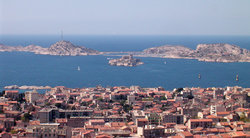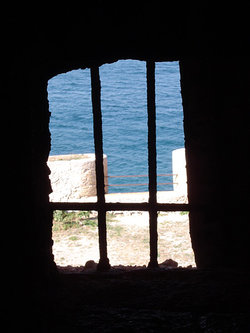|
|
Missing image Chateau.dif.arp.750pix.jpg The Chateau d'If from a boat |
The Château d'If is located on the small island of If, situated about a mile offshore in the Bay of Marseille, France. It is a square, three-storey building 28 m long on each side, flanked by three towers with large gun embrasures. The remainder of the island, which only measures 30,000 square metres, is heavily fortified; high ramparts with gun platforms surmount the island's cliffs.
It was built in 1524-1531 on the orders of King François I as a defense against attacks from the sea. However, its construction was extremely controversial. When Marseille was annexed to France in 1481, it retained the right to provide for its own defense. The castle was therefore seen by many of the local inhabitants as an unwanted imposition of central authority.
The castle's principal military value was as a deterrent; it never had to fight off an actual attack. The closest that it came to a genuine test of strength was in July 1531 when the Holy Roman Emperor Charles V made preparations to attack Marseille. However, he abandoned the invasion plan, perhaps deterred by the presence of the castle.
This was perhaps fortunate, given the weaknesses identified by the military engineer Vauban in a scathing report in 1701: "The fortifications look like the rock, they are fully rendered, but very roughly and carelessly, with many imperfections. The whole having been very badly built and with little care... All the buildings, very crudely done, are ill made."
The Château d'If's isolated location and dangerous offshore currents made it an ideal escape-proof prison, very much like the island of Alcatraz in California. Its use as a dumping ground for political and religious detainees soon made it one of the most feared and notorious jails in France. Over 3,500 Huguenots (French Protestants) were sent to If, as was Gaston Crémieux, a leader of the Paris Commune, who was shot there in 1871.
The island became internationally famous in the 19th century when Alexander Dumas used it as a setting in his novel The Count of Monte Cristo, published to widespread acclaim in 1844. In the book, the "Count" (actually the commoner Edmond Dantès) and his mentor, the Abbé Faria, were both imprisoned on If. After fourteen years, Dantès makes a daring escape from the castle, becoming the first person ever to do so and survive (in reality, none did). He adopts the identity of the Count of Monte Cristo and takes revenge on those who had falsely sent him to the island, driving them into bankruptcy and suicide.
As was common practice in those days, prisoners were treated differently according to their class and wealth. The poorest were literally at the bottom of the pile, being confined to a windowless dungeon under the castle. The wealthiest were much better off, living comparatively comfortably in their own private cells (or pistoles) higher up, with windows, a garderobe and a fireplace. However, they were expected to pay for this privilege, effectively forcing them to fund their own incarceration.
The castle's use as a prison was terminated at the end of the 19th century. It was demilitarised and opened to the public in 1890. It can now be reached by boat from Marseille's old port. Its fame as the setting for Dumas' novel has made it a popular tourist destination.
Perhaps because the real Château d'If has only a modest visual impact, other locations have stood in for it in film versions of Dumas' story. In the most recent adaptation starring Jim Caviezel (released in 2002), the castle was represented by St Mary's Tower - a watchtower on the cliff edge of Comino, the smallest of Malta's islands. It can readily be seen on the ferry crossing from Malta to Gozo.de:Château d’If fr:Château d'If


